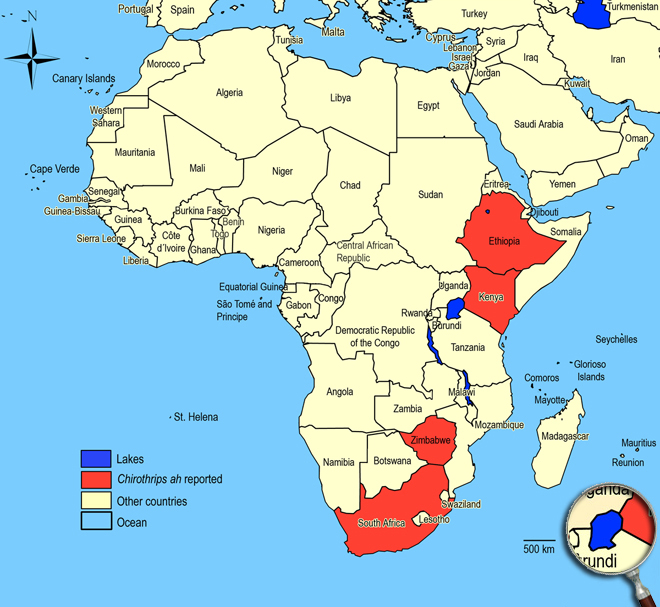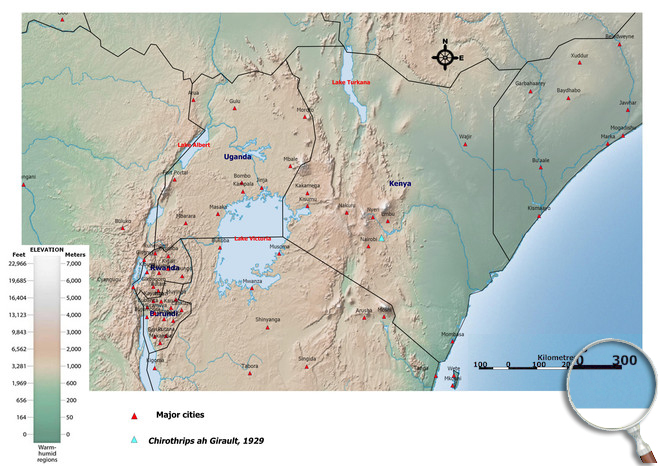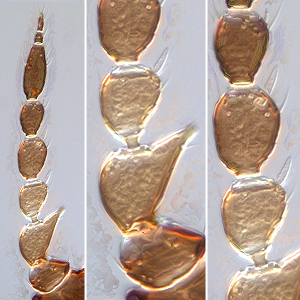Chirothrips ah Girault, 1929
Thripinae, Thripidae, Terebrantia, Thysanoptera
Figures
Fig. 1: 8-segmented antenna, scape, pedicel and III. segment, segments III and IV with simple sense cone
Fig. 2: Head dorsal with ocellar triangle
Fig. 3: Pronotum
Fig. 4: Meso- and metanotum
Fig. 5: Fore wing and distal region of fore wing
Fig. 6: Tergites IV and V
Fig. 7: Sternites IV and V with glandular pore plates, male
Fig. 8: Tergite VIII
Fig. 9: Tergites IX-XI
Introduction and recognition
Chirothrips ah damages forage grasses. Female macropterous; body, antennae and legs brown, tarsi paler; fore wings light brown and weakly shaded. Antennae 8-segmented; segment II with external margin hook-shaped with a small sensorium at apex, III & IV with stout simple sense cone (Fig. 1). Head small and scarcely prolonged in front of eyes; with 3 pairs of ocellar setae, pair III arise on anterior margins of ocellar triangle (Fig. 2). Pronotum trapezoidal; with 2 pairs of elongate posteroangular setae (Fig. 3). Meso- and metafurca with well-developed lateral flanges, but without median spinula. Metanotum irregularly reticulate; median pair of setae longer than lateral pair and arise at anterior margin; campaniform sensilla present (Fig. 4). Mid and hind tarsi 2-segmented; fore tibia not prolonged around fore tarsus. Fore wing pointed at apex; first vein with 2 or 3 setae on distal half; second vein with 5 or 6 setae (Fig. 5). Tergites with weak lines of sculpture medially (Fig. 6); posterior margin of tergites II-VIII with broadly rounded independent lobes fused at bases into continuous craspedum (Fig. 8 and 9), often weakly developed craspedum; ovipositor moderately developed and bearing rows of teeth. Sternites with 3 pairs of marginal setae, median pair on VII scarcely in front of margin; posterior margins of sternites II-VI with craspedum of independent small pointed lobes, also laterally on VII.
Male macropterous and similar to female; tergal sculpture stronger; sternites III-VII with large circular glandular area (Fig. 7).
Taxonomic identity
Species
Chirothrips ah Girault, 1929
Taxonomic history
Agrostothrips ah Bhatti, 1990
Chirothrips hoodi Jacot-Guillarmod, 1941
Common name
-
Present taxonomic position
Family: Thripidae Stephens, 1829
Subfamily: Thripinae (Stephens) Karny, 1921
Genus: Chirothrips Haliday, 1836
Genus description
The genus Chirothrips Haliday, 1836
Chirothrips currently includes about 45 to 50 species worldwide. Zur Strassen (1960) provided an identification key and catalogue of this genus for over 50 species, and Bhatti (1990) created six new genera for these species originally placed in the genus Chirothrips, and one of these, Arorathrips, is discussed in comparison to Chirothrips. Chirothrips appears to be a genus of Holarctic species, whereas Arorathrips is from the New World with a typical reduced mesothoracic endofurca. This genus has consistent characters that include small heads, short antennae with 8 segments, antennal segment II mostly expanded laterally (except in this key for Chirothrips guillarmodi), and a trapezoidal pronotum with 2 pairs of long posteroangular setae.
Species description
Typical key character states of Chirothrips ah
Coloration and body sculpture
Body color: mainly brown to dark brown
Surface of head, pronotum and fore legs: without obvious or with weakly reticulate sculpture
Antennae
Form of sense cones on antennal segments III and IV: emergent and simple on segments III and IV
Number of antennal segments: 8
Antennal segment I: without any setae on dorsal apical margin
Antennal segment II: without an exceptionally long seta at the inner apex
Antennal segment II shape: asymmetric with prolonged external margin slightly hook-shaped with a small sensorium at apex
Antennal segment III shape: symmetric
Length of antennal segment III and IV: antennal segment III similar in length to segment IV
Antennal segment IV and V: without a hyaline ring near the base
Antennal segment VI bears: not a remarkably dagger-shaped sensorium
Head
Distance between bases of ocellar setae III: greater than width of first ocellus
Head: distinctly prolonged in front of compound eyes
Ocellar setae I: present
Ocellar setae III: arising on anterior margin of, or in front of ocellar triangle
Ocelli: present
Length of postocular setae: not alternating short and long setae
Number of ocellar setae: 3
Prothorax
Number of pairs of long anteroangular setae: 0
Number of pairs of long posteroangular setae: 2
Number of pairs of elongate pronotal setae: 2
Pronotal blotch or internal apodeme: absent
Pronotum shape: trapezoidal
Pronotum posteromarginal/posteroangular setae: S2 longer than S3, not equal in length
Mesothorax
Mesosternal furca: without spinula
Metathorax
Metanotal campaniform sensilla: present
Metanotal median setae: S1 at anterior margin
Metanotum with dominant sculptured triangle medially: absent
Metasternal furca: without spinula
Shape of metathoracic furca: transverse, V-shaped
Metanotal median setae length: longer than lateral metanotal setae
Wings
Fore and hind wings: present, more than half as long as abdomen (macropterous)
Fringe cilia arising: from sockets
Fore wing veins: present
Fore- and hind wing surface: covered with microtrichia
Apex of fore wing: with prominent terminal setae
Fore wing anterior margin (costal vein): with setae and cilia but cilia longer than setae
Fore wing costal fringe cilia: arising at anterior margin of wing
Fore wing first vein: distinct from costal vein
Fore wing first vein setal row: incomplete, with setae not closely and uniformly spaced
Fore wing number of setae of second vein: 5-6
Fore wing second vein setal row: incomplete, with setae not closely and uniformly spaced
Fore wing shape: mainly parallel sided or margins run continuously towards each other
Fore wing surface: not reticulate
Fore wing first vein number of setae on distal half: 2-3
Fringe cilia on posterior margin near apex: distinctly wavy (undulated)
Length of fore wing costal setae at middle of wing: longer than half of median wing width
Shape of fore wing apex: with mainly posterior margin curved to join anterior margin
Fore wing extreme apex color: dark
Legs
Fore tibia: not prolonged around fore tarsus
Mid and hind tarsi: with two segments
Color of fore tarsi: pale or yellow, sometimes apical shaded or brown
Abdomen
Pleurotergites: not covered in microtrichia
Sternite II: with marginal setae but no discal setae
Craspedum on sternites II to V: present, toothed craspedum of independent small pointed lobes
Sternites IV, V and VI: with marginal setae but no discal setae
Sternite VII median posteromarginal setae S1: arising in front of posterior margin
Sternite VII: with marginal setae but no discal setae
Surface of lateral thirds of abdominal tergites: without regular rows of fine microtrichia
Tergites II to VII median setal pair: no more than 0.3 as long as median length of tergite
Tergites II to VIII discal campaniform sensilla: situated between the discal setae S1 and S2 or posteriorly
Craspedum on tergites IV to VI: present, broadly rounded independent lobes fused at base
Tergites IV and V median setal pair: shorter than distance between their bases
Tergites V to VII: without ctenidia laterally, but sometimes with rows of microtrichia
Tergite VIII ctenidia: without paired ctenidia laterally, sometimes with irregular microtrichia
Tergite VIII posteromarginal comb of microtrichia: absent
Tergite X: not tubular, longitudinally incomplete
Setae on abdominal tergite X: all setae slender

Similar or related species
The species can be distinguished from other species of the genus Chirothrips by the very slender and acute, slightly hook-shaped projection of the second antennal segment which bears a small sensorium at its apex, the ocellar setae III on anterior margins of ocellar triangle (other species with ocellar setae III anterolateral to fore ocellus), and median metanotal setae which are distinctly longer than lateral metanotal setae and arising at anterior margin (other species with metanotal median setae shorter than the lateral pair and arising well behind anterior margin except for Chirothrips guillarmodi and Chirothrips meridionalis with metanotal median setae arising at anterior margin). In contrast, antennal segment II of Chirothrips frontalis and Chirothrips manicatus is asymmetric with prolonged external margin bearing an exactly terminal small seta at tip, in Chirothrips guillarmodi it is symmetric, in Chirothrips meridionalis it is not strongly produced on outer margin, but drawn out into a sharply pointed angle, and in Chirothrips pretorianus it is asymmetric with prolonged external margin bearing a apical sense area. Chirothrips ah as well as Chirothrips meridionalis have tergites bearing broadly rounded independent lobes fused at bases into continuous craspedum (compared to Chirothrips guillarmodi with closely approximated but independent elongate lobes; Chirothrips frontalis with complete craspedum of unbroken border or flange; Chirothrips manicatus has a continuous craspedum with margin of weakly and rounded lobes; and Chirothrips pretorianus has a craspedum with independent small, triangular lobes). In Chirothrips ah as well as Chirothrips meridionalis posterior margin of sternites bears a craspedum of independent small pointed lobes (compared to Chirothrips guillarmodi with closely approximated but independent elongate lobes; Chirothrips manicatus with entire margin and a series of distinctive tubercles; Chirothrips pretorianus and Chirothrips frontalis without sternal craspedum). Moreover, the species has tergites II-VIII discal campaniform sensilla situated between the discal setae S1 and S2 or posteriorly (like in Chirothrips meridionalis and Chirothrips guillarmodi); other species of the genus Chirothrips have tergites II-VIII discal campaniform sensilla placed in front of the discal setae S1 (Chirothrips frontalis, Chirothrips manicatus, Chirothrips pretorianus), but somewhat farther apart than the setae S1.
Species of the genus Chirothrips are similar to Arorathrips mexicanus, but Arorathrips mexicanus has a greatly reduced mesothoracic furca (furcal pits widely separated), fore tibia prolonged at apex around the external margin of the first fore tarsal segment, and tergites II-V with transverse row of small tubercles along antecostal ridge. Whereas all species of the genus Chirothrips have furcal pits on mesosternum fused in the middle line, fore tibia not prolonged around fore tarsal segment, and the sculpture of antecostal ridge on tergites II-V is more or less elongated. Compared to described species of Chirothrips, Arorathrips mexicanus has the sternite VII median posteromarginal setae arising at margin, whereas in species of Chirothrips these setae arise in front of posterior margin.
Biology
Life history
As with other thrips species the life cycle from egg to adult is dependent on temperature. The full cycle can take less than a week to over a month and adults may live for more than one month producing several generations in one year depending on seasonal weather (Lewis 1973).
Host plants
Grasses (Poaceae), on the weed Deviľs whip, Achyranthes aspera.
Vector capacity
None identified, but possible mechanical distribution of phytopathogenic fungi and bacteria.
Damage and symptoms
All species in this genus Chirothrips breeding in grass flowers, sometimes their larvae and especially pupae are transported around the world within commercial grass seed.
Detection and control strategies
-
Additional notes
The precise host-plant on which this species breeds is not clear, but like all members of the genus Chirothrips the females lay eggs in the young flowers of certain grasses. Each larva apparently feeds within, and subsequently pupates within a single floret.
Biogeography
Australia, Papua New Guinea, Fiji, New Caledonia, Africa. Ethiopia (Ambo), Kenya, South Africa (Gauteng: Pretoria - 4500 ft.; Limpopo: Tshakuma - 35 miles east of Louis Trichardt, Ratomba - 21 miles east of Louis Trichardt 3150 ft., Entabeni Forest Station - 4500 ft., 20 miles north of Pietersburg - 4100 ft., 15 miles north of Mokopane - 4500 ft., 5 miles west of Pienaarsrivier - 3700 ft.; Mpumalanga: 13 miles west of Pilgrim's Rest, 12 miles south of Sabie, Nelspruit - 2350 ft., Malelane - 1200 ft.; Piet Retief - 4170 ft.; North West; KwaZulu-Natal: St. Lucia Estuary, Newcastle - 4000 ft.; Western Cape: Knysna, Gordon's Bay, Fish Hoek, Worcester - 790 ft.), Zimbabwe (9 miles northwest of Mutare, 35 miles north of Melsetter - 4500 ft., 8 miles north of Chipinge, Chirinda Forest - Mount Selinda).
African countries where Chirothrips ah has been reported

Occurence of Chirothrips ah in East Africa

Please click here for survey sites of all observed thrips species of Kenya, Tanzania and Uganda.

Bibliography
Bhatti JS (1990). On some genera related to Chirothrips (Insecta: Terebrantia: Thripidae). Zoology (Journal of Pure and Applied Zoology). 2 (4): 193-200
Girault AA (1929). New pests from Australia VI. Published privately, Brisbane, 4 pp
Hartwig EK (1948). Six new species of South African Thysanoptera, with statistical analysis of measurements. Journal of the Entomological Society of Southern Africa. 11: 83-126
Jacot-Guillarmod CF (1941). Studies on South African Thysanoptera - II. Journal of the Entomological Society of Southern Africa. 4: 80-100
Jenser G (1989). Data to the Thysanoptera fauna of Ethiopia. Acta Zoologica Academiae Scientiarum Hungaricae. 35 (3-4): 205-210
Lewis T (1973). Thrips: their biology, ecology and economic importance. Academic Press Inc., London Ltd., 349 pp
Minaei K & Mound LA (2010). Grass-flower thrips of the genus Chirothrips (Thysanoptera: Thripidae), with a key to species from Iran. Zootaxa. 2411: 33-43
Moritz G (2006). Thripse. Pflanzensaftsaugende Insekten, Bd. 1, (1. Auflage). Westarp, Hohenwarsleben, 384 pp. ISBN-13: 978-3-89432-891-7
Moritz G, Morris DC & Mound LA (2001). ThripsID - Pest thrips of the world. ACIAR and CSIRO Publishing Collingwood, Victoria, Australia, CDROM ISBN 1 86320 296 X
Moritz G, Mound LA, Morris DC & Goldarazena A (2004). Pest thrips of the world - an identification and information system using molecular and microscopical methods. Centre for Biological Information Technology, University of Queensland, Australia, CDROM ISBN 1 86499 781 8
Moritz G, O'Donnell C & Parrella M (2009). Pest thrips of North America. Centre for Biological Information Technology, University of Queensland, Australia, CDROM ISBN-13: 978 1 86499 940 2
Mound LA & Palmer JM (1972). Grass-flower infesting thrips of the genus Chirothrips Haliday in Australia. Journal of the Australian Entomological Society. 11: 332-339
Nakahara S & Footit RG (2012). Review of Chirothrips and related genera (Thysanoptera: Thripidae) of the Americas, with descriptions of one new genus and four new species. Zootaxa 3251: 1-29
zur Strassen R (1958). Studies in African Thysanoptera, 1. Journal of the Entomological Society of Southern Africa. 21 (2): 333-353
zur Strassen R (1959). Studies in African Thysanoptera, 3 (With notes on oedimerous males in Terebrantia). Journal of the Entomological Society of Southern Africa. 22 (2): 436-464
zur Strassen R (1960). Key to and catalogue of the known species of Chirothrips Haliday, 1836 (Thysanoptera: Thripidae). Journal of the Entomological Society of Southern Africa. 23 (1): 144-176
zur Strassen R (1960). Catalogue of the known species of South African Thysanoptera. Journal of the Entomological Society of Southern Africa. 23 (2): 321-367
----
Web links
Mound´s Thysanoptera pages
Thysanoptera Checklist
ICIPE Thrips survey sites
UNI Halle & Thrips sites
Thrips of California













